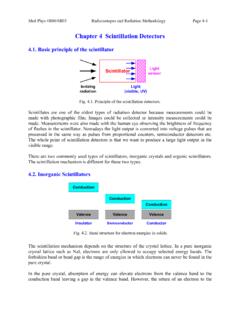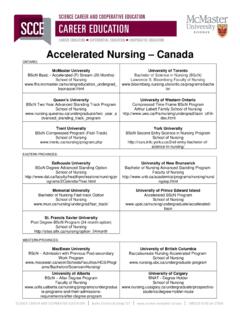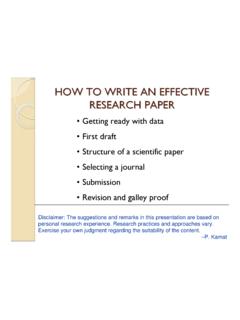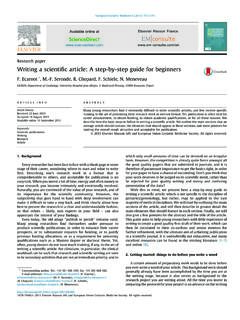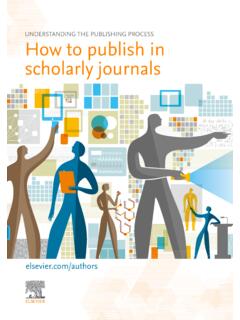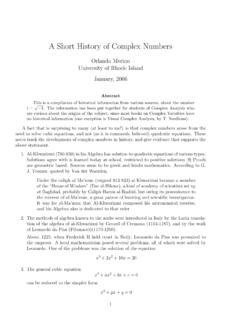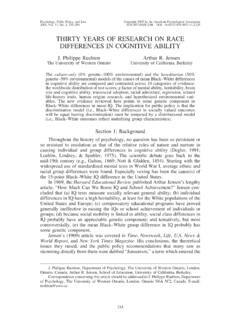Transcription of AN INTRODUCTION TO CRITICAL ANALYSIS OF …
1 AN INTRODUCTION TO CRITICAL ANALYSIS OF PUBLICATIONS IN EXPERIMENTAL BIOMEDICAL SCIENCES THE RESEARCH paper IN BASIC MEDICAL SCIENCES Scientists publish research reports for a variety of reasons. Ideally, a research report is a free communication by a scientist or a group of scientists informing their peers about a set of novel findings that either provide answers to puzzling problems or raise issues that are of academic or practical interest. At the opposite extreme lie reports that serve merely to add to the curriculum vitae of the investigators and have little or nothing important to say.
2 In the present discussion, we will assume that a scientific report represents the communication of new information from an investigator or a group of investigators to their peers. The Abstract or Summary of a paper is a vitally important element for several reasons. It is the section that is often used by bibliographic services (such as PubMed and Ovid) and is thus more widely disseminated than the whole paper . Furthermore, many readers scan the abstract to see whether the paper is worth perusing at greater length and, consequently, it is often the only component of the paper that they read.
3 It is crucial that the abstract be an accurate summary of the contents of the paper . The INTRODUCTION to a research report has two major objectives. (a) It provides a context for the study and (b) it specifies the particular aims of the reported study. Very few experimental studies spring ex nihilo from an investigator's laboratory. They usually develop from actual or perceived discrepancies from existing data and/or represent an attempt to extend and elaborate available knowledge. It is important that the investigator provide a brief background to the proposed study.
4 The emphasis should be on brevity, for the INTRODUCTION is not meant to be a detailed review but merely a capsule summary that provides a rationale for the second and most important part which is a clear statement as to why the study was undertaken. Methods and Materials: The objective of this section is to provide other investigators with enough information that will help them either repeat crucial sections or elaborate and extend the study. It is important that the investigator clearly spell out potential pitfalls in the methods used.
5 Evaluation of this section of the paper is very difficult for a variety of reasons. Most investigators use methods that have been used earlier by others or have been already published independently as a "methods" paper . Thus the methods section of a paper is often brief and terse. Phrases such as: "the enzyme was measured according to the modified method of Stern and Grumbach (1965)" abound. Often the word "modified" is a euphemism for major changes that leave little of the original method but saves the investigator much difficulty by referring to a published procedure.
6 Statistical procedures used are often included in the methods section. In assessing this section, it is important to determine whether the appropriate statistical tests were done. Many journals now insist that investigators pay especial attention to the statistical procedures used. The materials section of a paper should contain useful information for those interested in extending and elaborating the results reported. In pharmacological studies, it is important for instance to specify the sources of the drugs and chemicals used.
7 Results: The core of any experimental paper is the section that deals with the results obtained. In this section, the authors are expected to highlight clearly the information gathered using the methods described to fulfill the objectives of the study. The expectations with which the investigators began the study may or may not be borne out by the results presented. Usually results are presented without interpretation or discussion. However a number of journals permit the authors to discuss the implications of their results as they proceed.
8 This section includes figures and tables that present the data gathered, which must be critically assessed as well as the text. The Discussion section tries to place the results obtained in perspective. The information gathered is assessed in relation to the objectives of the study and the context in which the study began. Any discrepancies between anticipated and observed results are explained and elaborated upon. Often there is some repetition of the background material given in the INTRODUCTION but the discussion is more elaborate.
9 To many readers, the discussion section is CRITICAL since the investigators go beyond mere data gathering and attempt to provide explanations. It is important that CRITICAL assessment should differentiate reasonable extension of the results from undue speculation. The discussion often ends with a brief summary and conclusion. Other elements: The References are crucial to a published report. As noted earlier, very rarely are studies conducted in isolation. They often arise from actual or perceived problems in the published literature and it is important to adequately reference the context of the study.
10 Unfortunately this section of the report is rarely assessed critically. Many authors are quite careless about citations, and tend to cite their own work needlessly or cite reviews. Content ANALYSIS of references suggests that a large fraction of citations are perfunctory. It is also unfortunate that this element has received undue attention in bibliographic studies since it is not clear why authors cite specific studies. Although reviewers of papers are expected to assess this section of the paper , they rarely do so apart from commenting that certain papers should be cited (normally their own or that of a close colleague).
